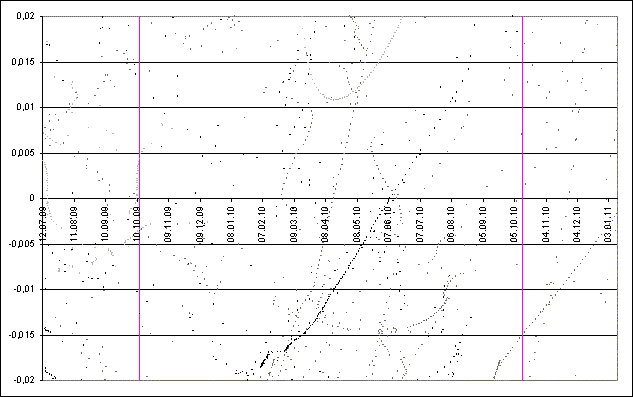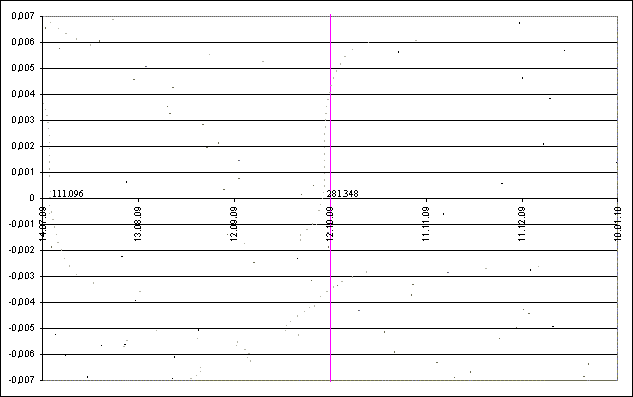Finlayids 2009: prediction of activity
to the list of predictions
Introduction
Computation characteristics
We'd like to introduce the results of Finlayid meteor stream simulation aimed to the prediction of shower activity in 2009. The simulation was made for the trails of latest 28 revolutions, i.e, from the 1807 trail. The Author used the program by S. Shanov and S. Dubrovsky "Comet's Dust 2.0" to calculate orbital elements of ejected meteor particles. To estimate expected ZHRs for different encounters the model by E. Lyytinen and T. van Flandern given in their paper [2] was used with some Author's alterations made in order to adopt the model for ejection velocity (Vej) instead of da0 (difference in a-semimajor axis) and to convert the model from the Leonid stream (for which it was originally created) to the Finlayids. The computation considered only gravitational forces. The prediction includes all encounters found within interval +/-0.007 a.u. The following parts of trails were computed: the first 15 rev. trails for ejection velocities [-50;100] m/s, 16-28 rev. trails - [-30;50] m/s.
Results
Introduction
Computation characteristics
We'd like to introduce the results of Finlayid meteor stream simulation aimed to the prediction of shower activity in 2009. The simulation was made for the trails of latest 28 revolutions, i.e, from the 1807 trail. The Author used the program by S. Shanov and S. Dubrovsky "Comet's Dust 2.0" to calculate orbital elements of ejected meteor particles. To estimate expected ZHRs for different encounters the model by E. Lyytinen and T. van Flandern given in their paper [2] was used with some Author's alterations made in order to adopt the model for ejection velocity (Vej) instead of da0 (difference in a-semimajor axis) and to convert the model from the Leonid stream (for which it was originally created) to the Finlayids. The computation considered only gravitational forces. The prediction includes all encounters found within interval +/-0.007 a.u. The following parts of trails were computed: the first 15 rev. trails for ejection velocities [-50;100] m/s, 16-28 rev. trails - [-30;50] m/s.
Results

Fig. 1. Space-temporal projection of Finlayid trails parts onto their minimal distance passages dirung the period 12.07.2009-12.01.2011 (correspondence between colours of the particles and their ejection velocities can be seen here).

Fig. 2. Detailed space-temporal projection of Finlayid trails parts onto their minimal distance passages dirung the period 12.07.2009-09.01.2010 (correspondence between colours of the particles and their ejection velocities can be seen here).

Fig. 3. Detailed space-temporal projection of Finlayid trails parts onto their minimal distance passages dirung the period 12.07.2010-12.01.2011 (correspondence between colours of the particles and their ejection velocities can be seen here).
Finlayinds 2009
In 2009 1919 trail inetersects the Earhs orbit on solar longitude 111.096°, the difference with the Earth passing this point of its own orbit is less than 3 day. However, high ejection velocity of the particles in the given part of 1919 trail (98.18 m/s) makes any activity from it very unlikely. Still, anyone may check the radiant 290.6°, Dec=-20.7, Vg=23.1 km/s with computed maximum time at 12:06 UT on 13.07.2009.
Finlayinds 2010
As shown on the Fig. 3, there are no expected encounters between the Earth and 15P trails, so we do not expect Finlayid meteor activity.
References
1. "Comet's dust 2.0" program by S. Shanov and S. Dubrovsky. [Used for orbital computations.]
2. Lyytinen E, van Flandern T. "Predicting the strength of Leonid outbursts", 2000, Icarus, P. 158-160.